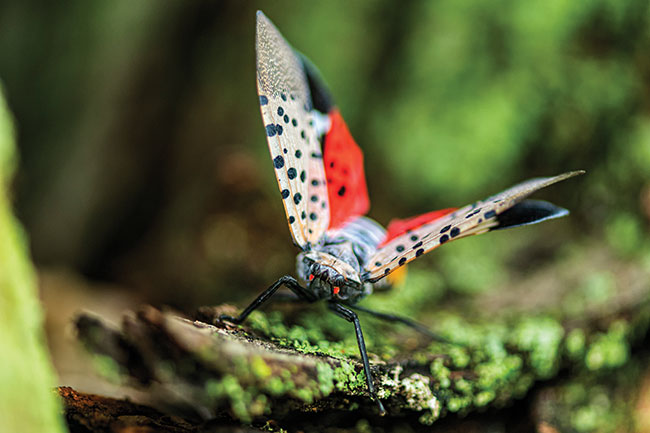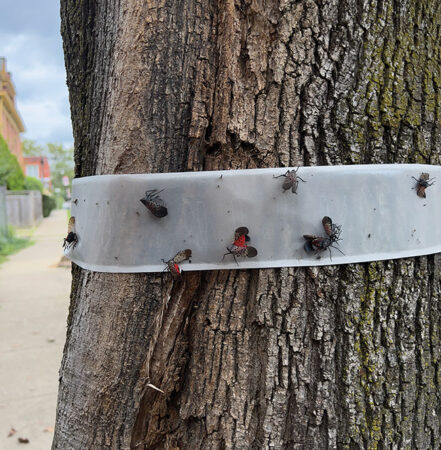
Features
Insects
New pest on our doorstep
Spotted lanternfly might not be the “fire and brimstone” pest it’s been painted as, but Canadian growers should be prepared for its arrival all the same.
March 26, 2024 By Alex Barnard
 The spotted lanternfly is an invasive sap-sucking plant hopper discovered in Pennsylvania in 2014. Since then, it has spread through the states north of Pennsylvania and is on Ontario’s doorstep.
Photo © cmannphoto / iStock / Getty Images Plus
The spotted lanternfly is an invasive sap-sucking plant hopper discovered in Pennsylvania in 2014. Since then, it has spread through the states north of Pennsylvania and is on Ontario’s doorstep.
Photo © cmannphoto / iStock / Getty Images Plus The impending arrival of the spotted lanternfly (SLF) in Canada has caused a good deal of concern. But is it all doom and gloom?
Brian Walsh, spotted lanternfly researcher with Pennsylvania State University Extension, says that’s not quite the case. Walsh has been part of the boots-on-the-ground management effort for several years, so his advice is tempered by plenty of experience.
In the early 2000s, South Korea’s fruit industry took a lot of damage when SLF arrived on the peninsula as an invasive pest. SLF was discovered in Berks County, Penn., in 2014.
“There was a lot of concern based on reports in South Korea, that it was going to be a massive problem for our forests or trees and our tree fruit and grape production,” Walsh says. “Thankfully a lot of those things haven’t really come to fruition, but, unfortunately, grapes have been heavily impacted by lanternfly.”
SLF are sap-sucking plant hoppers with one life cycle per year. They hatch in the spring and go through four instars, becoming adults in Pennsylvania generally in late July. Walsh says that, around the autumn equinox, they start laying eggs, which will overwinter and become the next generation the following spring. The adult SLF will freeze and die.
Anna Turbelin, a postdoctoral research scientist with the Great Lakes Forestry Centre in Sault Ste. Marie, Ont., has been conducting research on SLF’s ability to survive in adverse conditions like high winds and sub-zero temperatures. Preliminary results from summer 2023 showed that SLF egg masses could survive at -15 C or lower. So, Canadian winters aren’t likely to assist in controlling this pest.
While SLF are plant hoppers, that doesn’t mean they can’t get around. Walsh says it was an early fallacy that SLF couldn’t fly. He notes that they’re not agile fliers, like dragonflies, but they are able to flit and ride thermals to travel almost half a mile at a time. In addition to being clumsy fliers, SLF are clumsy at landing, often thudding into buildings, vehicles and even some unfortunate people.
“[They’re] definitely something that you take notice of, especially when one lands on your head,” Walsh says. “You quickly learn what they are – there’s not much else like them in the North American environment.”
Wendy McFadden-Smith, tender fruit and grape IPM specialist with the Ontario Ministry of Agriculture, Food and Rural Affairs, appreciates the willingness of American colleagues to share what they’ve learned in the near-decade of dealing with SLF, as it’s informing the Canadian strategy and plans for this pest.
“While it hasn’t been fire and brimstone like we originally feared, there are some very significant impacts that can happen if they’re left unchecked, and particularly to grapes – they are voracious feeders,” Walsh says. “They suck the sap out of the plants. They don’t bother the fruit so much, but they have the ability to actually kill grape vines in just a few seasons if they are not stopped. So that’s been a major issue.”
Plant death may take a few seasons, but that’s far from the only concern when it comes to the damage SLF can do.
“They feed on the phloem – the sugar-rich layer in the plant – and they pass a lot of sugars through in their ‘honeydew,’ which is the liquid excrement,” he explains. “Anything that lands on that honeydew becomes a substrate for sooty mold, and sooty mold can actually be just as bad and damaging to the crop, making it unusable.
“But the long-term concern is damage to the plants. We’re still understanding how the larger plants are being impacted. But we know flat-out the grapes are absolutely a concern.”
“Some of the work that’s been done in New York and Pennsylvania has shown that there’s reduced sugar accumulation and reduced coloration – in reds, for example, the anthocyanins,” says McFadden-Smith. “So, even before the lanternfly kills the grapevines, it will have an effect on how the crop matures.”
Walsh does express concern about the lack of insecticide options currently available for Canadian growers for this pest. However, the Pest Management Regulatory Agency (PMRA) registered a few insecticides for Emergency Use against spotted lanternfly in 2023.

Sticky traps on trees can catch spotted lanternflies as they climb up and down, but the traps also affect other insects, birds, and occasionally people.
Photo © bgwalker / iStock / Getty Images Plus
“They’re impacting grapes, but the growers and the researchers here in Pennsylvania responded pretty quickly. I’m not going to say that there’s no impact, but they’re not wiping out full vineyards. We saw one vineyard lost early on and adjustments have been made by other growers to control lanternflies to prevent the absolute catastrophic loss of the vineyard,” he says. “So, it’s a new problem for our grape growers to deal with. But it’s not hopeless.”
One other crop at risk is maple syrup. “Some of the preliminary studies that we’ve done in Pennsylvania have shown that just a few weeks of adult feeding on smaller trees can reduce sugar content by 40 per cent,” Walsh says. “That’s a massive number when you think about the number of gallons boiled to get to a gallon of syrup. And there’s questions about quality, as well as health of the tree with that loss of sugar.”
There are some cultural control measures growers can take, but physical control options aren’t really feasible for this pest.
McFadden-Smith notes that the Canadian Nursery Association and the Ontario Nursery Association are also concerned about SLF because it can lay its eggs on pots and transport pallets. The nursery industry’s recommendations involve conferring with sources of products coming in from the U.S., conducting major inspections and ensuring the items have been treated if they’re coming from a quarantine area.
Walsh jokes that the SLF must be listening in on discussions about the pest’s behaviour, as researchers have seen shifts in their feeding habits from earlier seasons – the plants they favour can change from year to year, as can how they spread. “Either they’re developing their palette, or the host quality has changed. So, it’s kept it interesting and has kept us on our toes.”
In late summer and fall 2023, there were three isolated sightings of SLF in Ontario in Fort Erie, Oakville and Niagara. However, the Canadian Food Inspection Agency (CFIA) found no other SLF near the three sightings and has yet to make any confirmed detections of SLF in Canada. (A detection is defined as a live SLF confirmed by the CFIA in the Canadian environment.)
“We’re trying to make sure everyone is aware and do whatever we can to try to get some tools available for Canadian growers to manage this pest,” McFadden-Smith says.
Stating “it’s not an if, it’s a when” SLF will come to Canada, Walsh encourages growers to get good, current information. “There are a lot of fallacies out there that that have been perpetuated, so get informed. Have a plan. Knowledge can really set your mind at ease if you have realistic expectations of what is probably just a matter of time.”
But Walsh also advises against despair or overreaction.
“Take a deep breath. It’s not good, but it’s not the end of the world. We are so much further along than we were just a few short years ago in understanding some of the stuff about this insect.”•
Want to learn more about spotted lanternfly and proactive measures you can take?
Here are some resources:
Penn State Extension: extension.psu.edu/spotted-lanternfly
CFIA (updates on confirmed detections, report a sighting): canada.ca/spotted-lanternfly
Invasive Species Council of B.C.: bcinvasives.ca/invasives/spotted-lanternfly/
Print this page